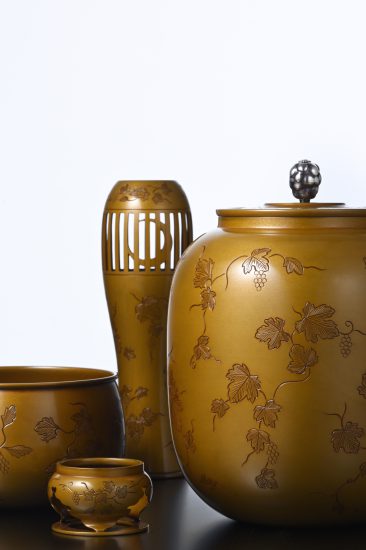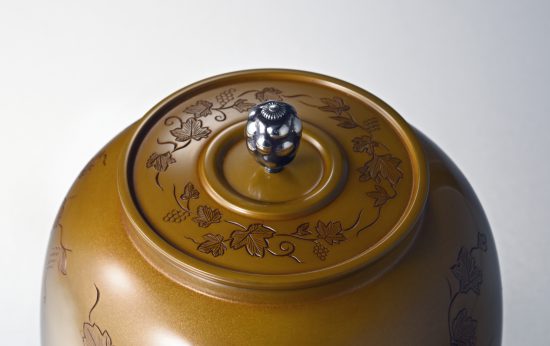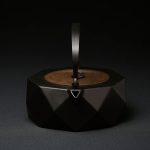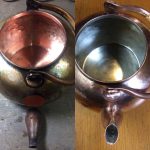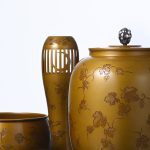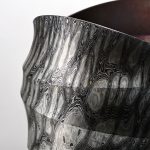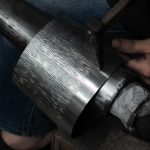This is a custom-made brass Kaigu with grape arabesque design. These items are forged and finished in traditional colors called Niiro, boiled colors. It was requested by a private customer living in Tokyo. After repeated discussions with the customer, it took two years to complete.

Some of you may be reminded of the “Sensou’s favorite Yugao Kaigu” owned by the Urasenke family (one of the styles of the Japanese tea ceremony) when you see the photo.
In the tea ceremony, a Kaigu is a set of four items: a Mizusashi (container for fresh-water), a Shakutate (ladle stand), a Kensui (waste water container), and a Futaoki (lid rest). They are highly prestigious tea utensils displayed on a Daisu (large utensil stand) or Nagaita (long board on which utensils are placed). Among them, the Yugao Kaigu loved by the fourth head of the Urasenke family, Sensou Soushitu, is a gem of great historical value. It is particularly famous among the “favorites” of Sensou, who left behind many excellent crafts collections. The customer initially requested a copy of this “Sensou’s favorite Yugao Kaigu”.
Sensou Soshitsu (1622-1697)
When we received the request, one of our proposals was to inherit the quality of the masterpiece while adding our own expression, technique, and flavor. In the course of our discussions, we narrowed down the main themes of the production to “passing on the good old things” and “building new traditions in a new era”.
While maintaining the appearance of color and shape as much as possible, the sculpture incorporates a new motif, “grapes”. The same vine and grass pattern as that of the evening glory expresses the continuous and unbroken connection between the two, while at the same time expressing the strong vitality and prosperity of grapes, which bear many fruits even in rough and arid land. The lid of the jug is decorated with lovely silver grapes. The size of the jug is one size smaller than the Seso Yoshi, as it is used by female tea masters. It is a size that fits comfortably in a woman’s small hand (most of the tea ceremony utensils that are considered masterpieces or masterpieces are for men).
By passing down the artifact with modifications to suit the user and the era in which it was used, the craftwork can be used in today’s lifestyles without difficulty.
For this project, we commissioned Kanaya-Gorosaburo, a leading metalworker in Kyoto who has assumed the name of the 16th generation. He is known for his outstanding skills in metal forging at a young age, especially in the shaping and coloring of brass. The Kanaya family’s unique coloring technique, in which brass is dyed slightly red, is known as “Gorosa-iro”. This is the essence of custom-made work, where we work together with the customer to conceive and materialize a work of art, and then order it from an outstanding young metalworker.
We are sure that this piece will be passed down as a masterpiece for the next 200 to 500 years.



